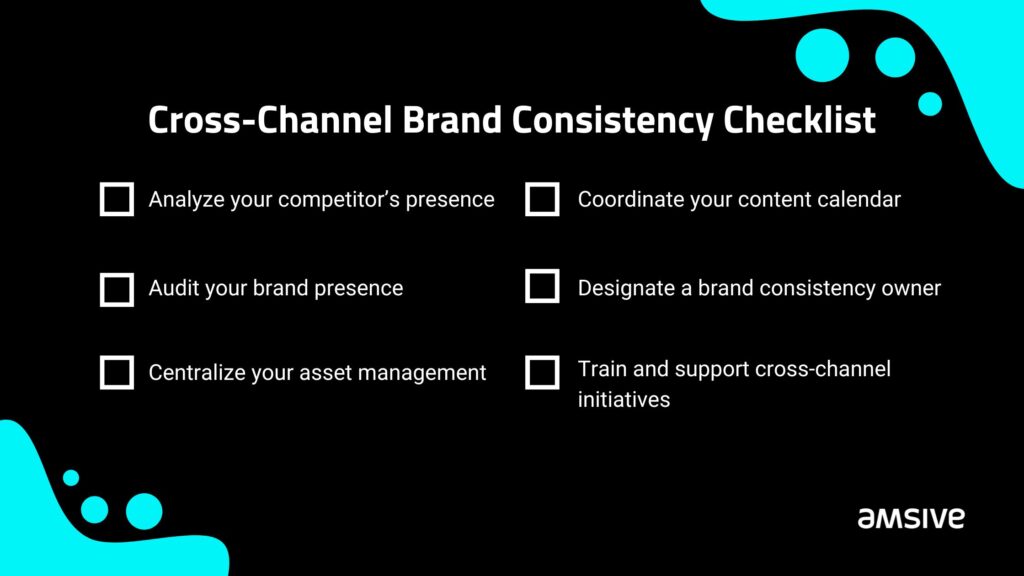Your brand is a balancing act. If you evolve too quickly, loyal customers may revolt. If you stick to what you’re good at, you may miss out on ways to grow your business. Balancing your brand across a fragmented multichannel marketing landscape will never get any easier—but having a blueprint helps.
Explore developing your brand style guide, collecting feedback, understanding your target audience’s preferences, and improving your overall cross-channel brand consistency.
Jump To:
Continually develop your brand style guide
Brand guidelines are living documents that need to evolve with your business. If you haven’t already, revisit your brand style guide to ensure a cohesive and consistent brand identity. According to Hubspot, a brand style guide is “the guardrails that you share both externally and internally that help you say who and what your brand is.” These should remain consistent and thorough, including relevant examples of what you can and cannot do to provide crystal clear clarity. Taking steps to keep your brand style guide up to date with your business should include:
Document and align new elements
As the brand evolves, so should the brand guidelines. It is important to keep up with the documentation when any shifts occur. If any of the verbal or visual elements are added or altered, these changes should be outlined with the same instructions given for other guide components. These changes should include appropriate use on channels, in campaigns, or across touchpoints. This process will strengthen consistency, aligning your creative and messaging to foster deeper connections with your audience. These updates should be aligned with any changes in brand strategy.
Collect feedback
Get insights and feedback by consulting stakeholders, internal team members, and customers, if possible. Internally, discussing your style with copywriters, designers, and executives can help you determine whether your guidelines are properly aligned with brand strategy.
If your brand’s goals, mission, audience, or other factors change, it may be time to take a fresh look—but major changes should not be taken lightly. Think of major branding disasters like New Coke and Tropicana changing their packaging. Conducting surveys, interviews, or focus groups are effective ways to gauge your audience’s sentiment toward your branding before you launch. More subtle changes over time prove to be more successful than dramatic changes that can alienate your loyal customer base.
Give examples and best practices
Including written or visual examples of your brand guidelines can help any future employees or stakeholders who join your business. Examples and best practices can illustrate how your brand elements are effectively applied and shown in successful campaigns, designs, or messages that align the most closely with your brand’s identity and values.
Monitor implementation
By monitoring and tracking the use of your brand’s best practices, you can identify any areas or gaps where additional guidance or support may be needed around implementation. Based on these insights, you can improve brand consistency across touchpoints, which can improve overall brand recognition among consumers.
As you fine-tune your brand’s practices and enhance consistency across channels, gaining a clearer insight into your target audience’s preferences increases in importance, helping you maximize your engagement and impact.

Understand your target audience’s preferences
If Nike were to suddenly shift their brand identity, Instagram would be the best place to hard-launch a new social strategy. Nike has a substantial following across all major social platforms, including Instagram, Facebook, X (formerly Twitter), TikTok, YouTube, and Reddit. They could also target their audiences in print, OOH, on television—any number of combinations, if their new messaging and imagery were consistent, and aligned with the platforms and channels that their audiences are most likely to engage with.
It’s important for brands to understand where their audiences are most likely to engage with them. Different demographics and consumer segments have different preferences for how and where they consume content and interact with brands. Gen Z may look for their favorite brands on TikTok, while Boomers may be more likely to engage with content found on search engines or direct mailers (or, depending on the brand, also on TikTok). By understanding your audience’s habits and preferences, you can spread your ad spend across the channels that are most likely to get their attention and drive engagement.
Understanding your audience’s preferences will also help optimize your ad spend and marketing budget. By focusing the bulk of your spending on the channels that are most relevant to your audience, you’re more likely to positively impact your marketing efforts and improve your ROI.
Choosing your audiences’ preferred marketing channels can create positive associations and interactions with your customers. Investing in and leveraging the channels your consumers trust and are most relevant to your audience can create a deeper, more positive connection. Whether it’s through direct mail, email, in-person events, or social media, investing in your audience’s preferred channels and formats can increase the likelihood of conversions and repeat engagement.
Improve cross-channel brand consistency
Ensuring cross-channel brand consistency in a multichannel strategy will help your brand identity remain cohesive and build trust among your consumers. Beyond aligning your messaging and visuals, go into planning with the understanding of your consumer’s preferences and expectations.
If you’re considering rebranding, consider the channels you’d like your brand to engage on and how that affects your brand. For example, for X (formerly Twitter), having a clear brand voice and personality is key. TikTok will rely on more authentic, less polished assets but should still feel distinctly like your brand.
Set clear goals of what you want a rebrand to achieve. For example, bring in a younger demographic or account for growth into additional categories and industries. A strong brand brief with your mission, vision, and goals will set the stage for an effective rebranding.
Taking steps toward improving your cross-channel consistency can include:
Audit your brand presence
Understanding your current brand presence across channels can help you identify inconsistencies in your messaging, tone, visuals, or user experience. Channel evaluation can include your social media, email marketing, out of home experiences, or direct mail.
Analyze competitor’s brand presence
Look at how your competitors are implementing cross-channel branding. Look at the engagement on their social posts; research what their keywords and organic traffic pull in. Understanding their performance can give you a better view of your position in the marketing landscape. There are tools that can help you monitor competitor messaging, including Mathematics, Vivvix, SEMRush, Competiscan, and SpyFu. Many allow you to set up alerts and track performance in near real-time.
Centralize your asset management
Having a repository for content templates, graphics, images, logos, and videos ensures that anyone working on your brand is using the most recent, approved assets for your brands. Ensuring this consistency can improve your brand’s loyalty and recognition across touchpoints. Digital Asset Management (DAM) will allow you to catalog and easily share your creative assets with internal stakeholders. Some of the options include Brandfolder, Widen Collective, and Bynder.
Train and support cross-channel initiatives
Educating internal and external teams on your brand guidelines will improve guideline implementation and cross-channel consistency. Continually supporting internal resources and guiding these initiatives can help break down internal silos and encourage collaboration between departments.
Coordinate your content calendar
By planning and scheduling your content with a focused and synchronized approach, you can strategically align messaging themes and promotions across channels. This can help you avoid sharing conflicting or duplicative information with your consumers.
Designate a brand consistency owner
Decide who owns brand consistency–especially for large brands with many stakeholders and divisions. It is important that someone owns the role of ensuring the branding stays consistent. In some cases, internal policing can be tricky, and many brands can seek third-party help. This can be in the form of an agency or AI tools such as CreativeX. Software like Salesforce’s Marketing Cloud and Adobe Campaign can streamline the process of delivering cohesive messaging across platforms. They help you implement your messaging and analyze performance, allowing brands and businesses to maximize their marketing efforts.

Which step will you take first?
With such a wide variety of platforms for brands to engage on, a brand’s success can be made or broken by its consistency across channels. Disjointed branding has the potential to confuse customers, losing to less efficient marketing and lower ROI. Prioritizing relevant channels optimizes spending and fosters positive associations.
Brand consistency can increase recognition, driving engagement and loyalty. Coordinating content, incorporating key visual elements, logos, and colors, and utilizing multichannel tools streamline messaging for a unified brand experience, fueling growth and loyalty.
Curious about transforming your brand’s performance? Reach out for a comprehensive brand audit for an overview and a tailored strategy to ensure consistent messaging and visuals across all channels.






